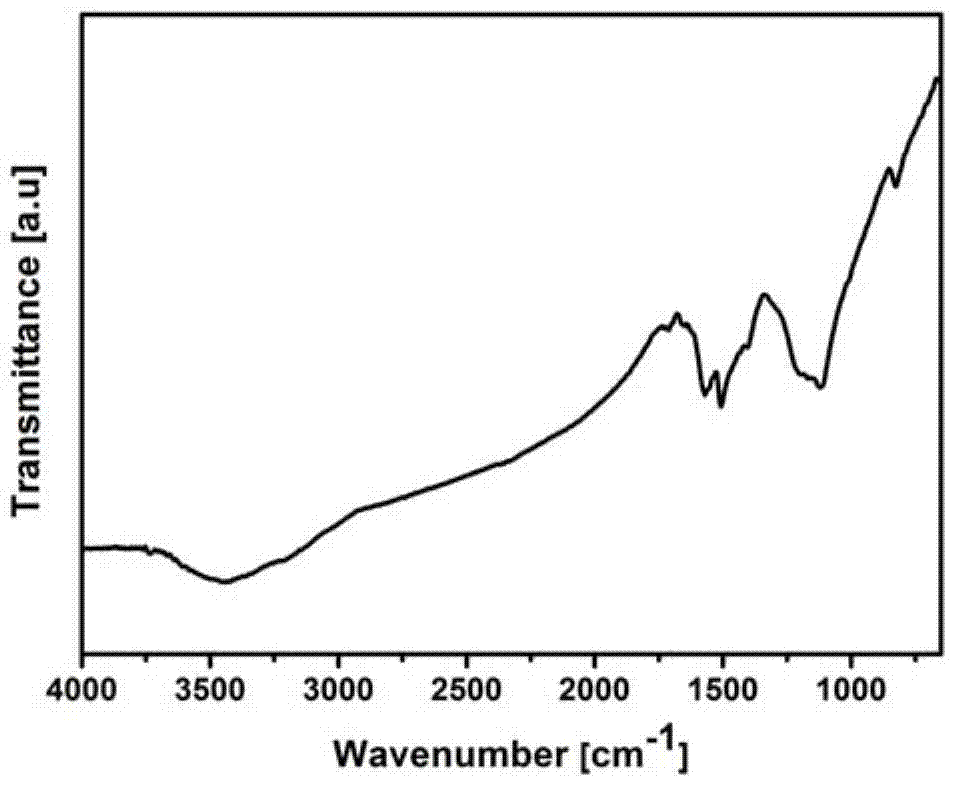Diaminobenzene-functionalized graphene nanomaterial and preparation method thereof
A technology of diaminobenzene and nanomaterials, applied in the direction of fibrous fillers, dyed low-molecular-weight organic compounds, etc., can solve the problems of high toxicity of coupling reagents, complicated operation and high reaction temperature, and achieves improved thermal stability and easy control. , Improve the effect of interface compatibility
- Summary
- Abstract
- Description
- Claims
- Application Information
AI Technical Summary
Problems solved by technology
Method used
Image
Examples
preparation example Construction
[0032] Such as figure 1 Shown, a kind of diaminobenzene functionalized graphene nano material and preparation method thereof, the method comprises the following steps:
[0033] Step 1, adopt the improved Hummers method to prepare graphite oxide solid with natural graphite powder;
[0034] Step 2. Ultrasound for 2-10 h to prepare a DMF suspension of graphene oxide, the ratio of graphite oxide to DMF solvent is 7.5-15 mg / mL;
[0035] Step 3. Prepare the DMF solution of PA, the ratio of PA to DMF solvent is 1:10~1:500 g / mL, and the stirring temperature range is 25~80 °C; PA is p-phenylenediamine, m-phenylenediamine and o-phenylenediamine Any one of the diamines;
[0036] Step 4. Mix the suspension in step 2 with the PA solution in step 3. The mass ratio of graphene oxide to PA is 1:10~10:1, heat to 70~100°C and stir, and the reaction time is 5~24 h;
[0037] Step 5, filter under reduced pressure, wash and dry to obtain the diaminobenzene functionalized graphene nanomaterial. ...
Embodiment 1
[0039] The first step, the preparation of graphite oxide solid;
[0040] At 80 °C, 20 g of natural graphite was pre-oxidized with 30 mL of concentrated sulfuric acid, 10 g of potassium persulfate and 10 g of phosphorus pentoxide, washed with water to pH = 7, and dried overnight at room temperature for use;
[0041] Cool 460 mL of concentrated sulfuric acid to about 0 °C, then add 20 g of pre-oxidized graphite into it, slowly add 60 g of potassium permanganate, so that the temperature of the system does not exceed 20 °C, after the addition is completed, raise the temperature to 35 °C, and stir After 2 h, 920 mL of deionized water was slowly added in batches so that the system temperature did not exceed 98 °C. After stirring for another 15 minutes, 2.8 L of deionized water and 50 mL of 30% hydrogen peroxide were added. The resulting bright yellow suspension was filtered under reduced pressure and washed. Until there is no sulfate ion in the filtrate, and when it is ...
Embodiment 2
[0049] The first to third steps are the same as steps one to three in Example 1.
[0050] In the fourth step, the p-phenylenediamine solution in the third step was slowly added dropwise to the GO suspension prepared in the second step, heated to 70 °C, and vigorously stirred for 24 h;
[0051] The fifth step is the same as step five in Example 1.
PUM
 Login to View More
Login to View More Abstract
Description
Claims
Application Information
 Login to View More
Login to View More - R&D
- Intellectual Property
- Life Sciences
- Materials
- Tech Scout
- Unparalleled Data Quality
- Higher Quality Content
- 60% Fewer Hallucinations
Browse by: Latest US Patents, China's latest patents, Technical Efficacy Thesaurus, Application Domain, Technology Topic, Popular Technical Reports.
© 2025 PatSnap. All rights reserved.Legal|Privacy policy|Modern Slavery Act Transparency Statement|Sitemap|About US| Contact US: help@patsnap.com



